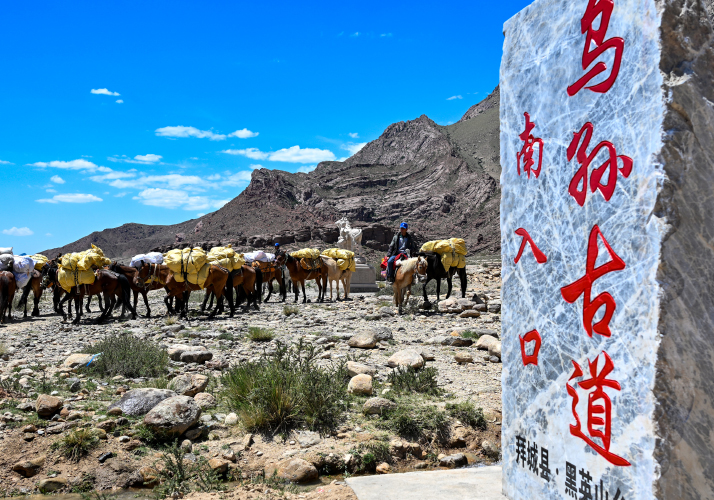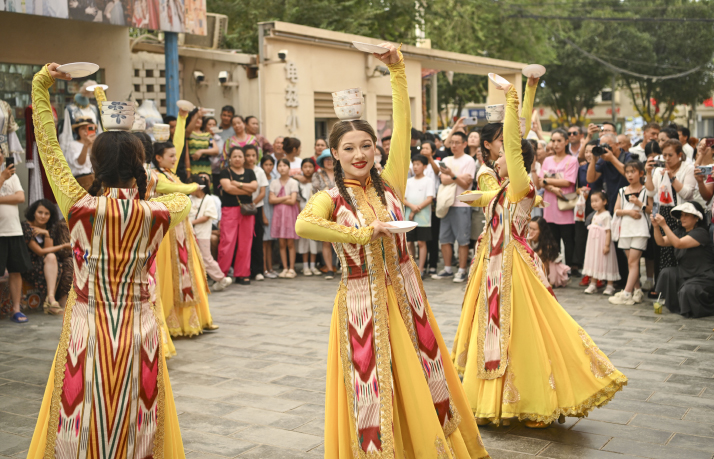| Xinjiang Today |
| Local regimes throughout the history of Xinjiang | |
|
|
 The entrance of the Wusun ancient road in Baicheng County on June 9, 2024 (XINHUA)
The Chinese saying "What has long been divided will unite, and what has long been united will divide" reflects a recurring theme in China's ancient history. Small kingdoms or separatist regimes existed in the Central Plains, the heartland of ancient China, in different periods; similarly, Xinjiang also witnessed several local regimes dividing the region. Nevertheless, no matter how long these regimes divided Xinjiang or how serious the situation was, the region was ultimately united. In different periods in Xinjiang, there were local regimes, such as the 36 states of the Western Regions in the Han Dynasty (206 B.C.-A.D. 220), the Kara-Khanid Khanate and the Uighur Kingdom of Gaochang in the Song Dynasty (960-1127), the Chagatai Khanate in the Yuan Dynasty (1206-1368) and the Yarkant Khanate in the Ming Dynasty (1368-1644). But these were all local regimes within the territory of China; they were never independent countries. These local regimes had a strong sense of national identity and acknowledged themselves as branches or vassals of the Central Plains authorities. Among the local regimes in ancient Xinjiang, three with relatively significant influence stand out: the Wusun State, the Kara-Khanid Khanate and the Junggar Khanate. The Wusun State In 138 B.C., Zhang Qian, an imperial envoy in the Han Dynasty, was dispatched by Emperor Wudi on a mission to the Western Regions. At that time, the Western Regions were home to 36 states, most of which were small, with populations ranging from a few hundred to several thousand, and in some cases up to 20,000 or 30,000. Among the more prominent were the Wusun, Qiuci, Loulan, Shache, Dayuan, Parthia and Rouzhi. Of these, the most powerful and largest state was the Wusun. According to the Book of Han, "The Wusun State, ruled by the Great Kunmi from Chigu City, lies 8,900 li (roughly 4,500 km) from Chang'an. It had 120,000 households, a population of 630,000, and could mobilize 188,800 warriors." The Wusun people were nomads who followed the herds and the grass, with customs similar to the Xiongnu. The Xiongnu was a nomadic tribe that made its first appearance in northern Eurasia in the third century B.C., migrating westward in the second century before vanishing in the fifth century. The Wusun's land was rich in horses, with the wealthier owning up to 4,000 or 5,000. Its people were described as bold, fierce, greedy and untrustworthy, frequently engaging in raiding, making them the strongest state in the region. At the time, the Xiongnu people often launched raids on both the Han Dynasty and the Wusun. This led to an alliance strategy between the two sides through marriage. In 105 B.C., Emperor Wudi married Princess Liu Xijun to the Wusun king Liejiaomi. As Liejiaomi was advanced in age, he arranged for the princess to later marry his grandson and heir Junxumi, following the nomadic custom where a deceased king's young widow would marry a son, grandson or brother. After marrying Junxumi and giving birth to a daughter, Princess Liu Xijun died of illness after living in the Wusun for just over four years. Following her death, Junxumi again wrote to the Han court requesting another Han princess. In 101 B.C., Princess Liu Jieyou was sent. A few years later, Junxumi died of illness, and his cousin Wengguimi succeeded him as king. According to custom, Princess Liu Jieyou married Wengguimi, and the two had two sons and two daughters. In 72 B.C., Princess Liu Jieyou and the Wusun king jointly petitioned the Han emperor to send troops against the Xiongnu. Emperor Xuandi responded by deploying 150,000 cavalry, helping the Wusun deal a significant blow to the Xiongnu. By 70-69 B.C., the Xiongnu had suffered a decisive defeat. After the Han Dynasty, historical records about the Wusun become sparse. According to the Tongdian, or Comprehensive Canons, compiled during the Tang Dynasty (618-907), "the former territory of the Wusun during the Western Han period (206 B.C.-A.D. 25) became the land of the king of Later Cheshi in the Eastern Han period (25-220), and in successive dynasties, it was inhabited by various nomadic ethnic groups (generally categorized as Hu back then—Ed.)," suggesting that the Wusun state was eventually dissolved and replaced by the Later Cheshi Kingdom.  A dance performance in Qiuci Alley in Kuche (Kuqa), Aksu Prefecture, on July 17. The alley is a historic area in Kuche, named after Qiuci, one of the 36 states of the Western Regions in the Han Dynasty (206 B.C.-A.D. 220) (XINHUA)
The Kara-Khanid Khanate The Kara-Khanid Khanate holds a significant place in Xinjiang's history, primarily because it marked the formative period of Islam in the region. In 840, the Uighur Khanate, located in present-day Mongolia and Inner Mongolia Autonomous Region of China, collapsed rapidly due to natural disasters and internal turmoil. One major branch of the Uighurs migrated westward into what is now Xinjiang and established the Kara-Khanid Khanate. Situated at the crossroads of the Silk Road, the Kara-Khanid Khanate became a hub for the convergence of Eastern and Western civilizations. Initially, it was not an Islamic regime. Its dominant belief systems included Shamanism and Zoroastrianism, with the presence of Manichaeism and Buddhism as well. Various ethnic groups such as the Uighurs, Karluks and Yagma interacted and merged culturally in this region. During the rule of Oghulchaq Khan, the Kara-Khanid Khanate engaged in fierce conflicts with the Persian Samanid Dynasty. To strengthen his position, Oghulchaq Khan gave asylum to Nasr Samanid, a prince fleeing from another tribe. Under Nasr Samanid's influence, Oghulchaq Khan's nephew, Satuq Bughra, converted to Islam and began secretly building his own power base. With the advice of Nasr Samanid, Satuq Bughra eventually overthrew and killed his uncle, seizing the throne as the third ruler of the Kara-Khanid Khanate. Satuq Bughra Khan vigorously promoted Islam, modeling his rule on Persian-Islamic governance. As religious scholars flourished and mosque-based economies grew, Islam's foundation in the region solidified. After Satuq Bughra Khan's death, his son Musa Baytash succeeded him. In 960, Musa Baytash Khan officially declared Islam the state religion. From this point on, Xinjiang developed a religiously plural structure, with Buddhism prevailing in the north and Islam in the south. The Kara-Khanid Khanate rulers maintained good relations with the Song Dynasty, frequently sending tribute missions and acknowledging the authority of the Song. According to the Song Huiyao Jigao, or Collected Essentials From the Song Government Manuscript Compendium, more than 50 diplomatic missions from the Kara-Khanid Khanate were dispatched to the Song court. In 1041, the Kara-Khanid Khanate split into eastern and western branches. The Eastern Khanate fell in 1211, and the Western Khanate in 1212, marking the end of the Kara-Khanid era. The Junggar Khanate The Junggar Khanate was the last separatist regime in the history of Xinjiang. In the Qing Dynasty (1644-1911), the imperial court quelled a rebellion launched by the Junggar regime and later renamed the Western Regions as "Xinjiang," meaning "land newly returned." The Junggars were originally a nomadic tribe centered in the Ili River Valley during the Ming Dynasty. Following the fall of the Ming, the leader of the Junggar acknowledged the authority of the Qing Dynasty. Over time, however, the Junggar tribe grew in strength. In 1678, under the leadership of Galdan Boshugtu Khan, the Junggar Khanate was established. Galdan Boshugtu Khan was not only a military leader but also a follower of Tibetan Buddhism. He studied in Lhasa and built close ties with the Fifth Dalai Lama, subsequently introducing Buddhism as the state religion of the Junggar Khanate. Galdan Boshugtu Khan harbored ambitious expansionist goals, engaged in frequent military campaigns and even colluded with Tsarist Russia, aiming for territorial secession from China. In 1690, Emperor Kangxi personally led a military expedition to suppress the rebellion of Galdan. The war against Junggar separatist forces lasted nearly 70 years, involving three Qing emperors, and finally ended in 1758. During this period, the Junggar Khanate gained control over Central Asian trade routes along the Silk Road and, in 1717, even launched an incursion into Xizang. Historians view this prolonged campaign not only as a critical move to safeguard China's territorial integrity but also as the final clash between nomadic and agrarian civilizations within the country. The nomadic-based regime collapsed entirely, losing the capacity to challenge the central imperial authority. China once again became a unified multiethnic state. The Qing court quelled the rebellion launched by the Junggar regime, defining the northwestern border of China. It then adopted more systematic policies for governing Xinjiang. In 1762, the Qing government established the post of Ili General and adopted a mechanism combining military and political administration. In 1884, it established a province named Xinjiang. Looking back, it is clear that Xinjiang's development has been closely related to that of China. Though it has experienced periods of division and unification, central governance and national unification have consistently been the dominant trajectory throughout its history. Comments to lanxinzhen@cicgamericas.com |
|
||||||||||||||||||||||||||||
|